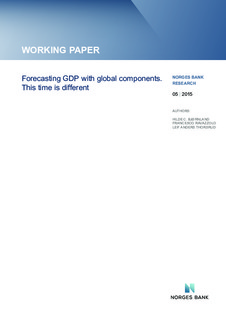| dc.contributor.author | Bjørnland, Hilde C. | |
| dc.contributor.author | Ravazzolo, Francesco | |
| dc.contributor.author | Thorsrud, Leif Anders | |
| dc.date.accessioned | 2018-04-25T10:00:02Z | |
| dc.date.available | 2018-04-25T10:00:02Z | |
| dc.date.issued | 2015 | |
| dc.identifier.isbn | 978-82-7553-857-2 | |
| dc.identifier.issn | 1502-8143 | |
| dc.identifier.uri | http://hdl.handle.net/11250/2495869 | |
| dc.description.abstract | A long strand of literature has shown that the world has become more global. Yet, the recent Great Global Recession turned out to be hard to predict, with forecasters across the world committing large forecast errors. We examine whether knowledge of in-sample co-movement across countries could have been used in a more systematic way to improve forecast accuracy at the national level. In particular, we ask if a model with common international business cycle factors forecasts better than the purely domestic alternative? To answer this question we employ a Dynamic Factor Model (DFM) and run an out-of-sample forecasting experiment. Our results show that exploiting the informational content in a common global business cycle factor improves forecasting accuracy in terms of both point and density forecast evaluation across a large panel of countries. In line with much reported in-sample evidence, we also document that the Great Recession has a huge impact on this result. The event causes a clear preference shift towards the model including a common global factor. Similar shifts are not observed earlier in the evaluation sample. However, this time is different also in other respects. On longer forecasting horizons the performance of the DFM deteriorates substantially in the aftermath of the Great Recession. This indicates that the recession shock itself was felt globally, but that the recovery phase has been very different across countries. | nb_NO |
| dc.language.iso | eng | nb_NO |
| dc.publisher | Norges Bank | nb_NO |
| dc.relation.ispartofseries | Working Papers;5/2015 | |
| dc.rights | Attribution-NonCommercial-NoDerivatives 4.0 Internasjonal | * |
| dc.rights.uri | http://creativecommons.org/licenses/by-nc-nd/4.0/deed.no | * |
| dc.subject | JEL: C11 | nb_NO |
| dc.subject | JEL: C53 | nb_NO |
| dc.subject | JEL: C55 | nb_NO |
| dc.subject | JEL: F17 | nb_NO |
| dc.subject | BDFM | nb_NO |
| dc.subject | Bayesian dynamic factor model | nb_NO |
| dc.subject | forecasting | nb_NO |
| dc.subject | model uncertainty and global factors | nb_NO |
| dc.title | Forecasting GDP with Global Components. This Time Is Different | nb_NO |
| dc.type | Working paper | nb_NO |
| dc.description.version | publishedVersion | nb_NO |
| dc.subject.nsi | VDP::Samfunnsvitenskap: 200::Økonomi: 210::Samfunnsøkonomi: 212 | nb_NO |
| dc.source.pagenumber | 39 | nb_NO |

